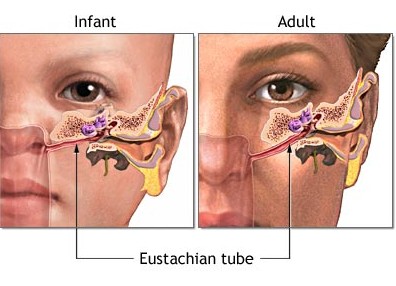
Eustachian tube dysfunction can lead to discomfort when flying.The middle ear is an air-filled space separated from the external ear by the tympanic membrane (ear drum). The Eustachian tube connects the middle ear space to the nasopharynx at the back of the nose. It normally opens with swallowing or yawning and allows equalization of pressure in the middle ear.
During ascent in an airplane, there is a decrease in cabin air pressure, leading to a relative increase in the pressure of the middle ear. If the Eustachian tube is able to open normally, air will leave the middle ear until the pressure is equalized. If the tube is unable to open due to a cold or chronic Eustachian tube dysfunction, the excess pressure can lead to discomfort. During descent, relative negative pressure in the middle ear can lead to retraction of the ear drum, which can be quite painful and lead to the ear feeling clogged.
Patients with colds or sinus infections should avoid flying if possible. However, if air travel cannot be avoided, here are some things that can help prevent ear discomfort due to Eustachian tube dysfunction:
Begin taking the over-the-counter decongestant pseudoephedrine (Sudafed®) 24 hours prior to the flight according to the directions on the package. If you experience discomfort, continue taking it for 24 hours after the flight.
Purchase a nasal decongestant spray, either oxymetazalone (Afrin®) or phenylephrine (Neo-Synephrine®). Following the directions on the package, use the spray 15 minutes before the flight leaves. Use it again 45 minutes before the plane is scheduled to land.
If you experience discomfort on ascent, plug your nose and swallow. This will help remove excess air from the middle ear through the Eustachian tube. During descent, gently blow with your nose plugged and your mouth closed (called a Valsalva maneuver). This will force air through the Eustachian tube into the middle ear space and equalize the pressure.
If you have heart or prostate problems, you should consult with your physician before using over-the-counter decongestants.
In some cases allergies contribute to poor Eustachian tube function and may lead to problems on flights. If this is a contributing factor, you should consult your physician and obtain a prescription for a nasal steroid preparation, and use it for at least several days before your trip and until you return home, if feasible.
Individuals who have severe Eustachian tube dysfunction may get middle ear and tympanic membrane hemorrhages and subsequent accumulation of middle ear serous fluid after a painful descent. This so-called barotrauma can be quite worrisome, as it may interfere with hearing and in some cases lead to dizziness. In such a circumstance, a visit to an ear specialist is needed. If this occurs repeatedly with flying, the ear specialist may recommend the in-office placement of a pressure equalizing tube (PE tube). The PE tube remain in the ear drum for many months and will prevent the consequences of Eustachian tube blockage, since a tiny opening in the ear drum will allow pressures to immediately equalize during all phases of the flight.
Call Nevada Ear + Sinus Institute at (702) 735-7668 for more information or to schedule an appointment.